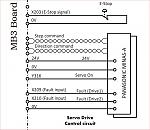
Originally Posted by
Doddy

Okay, if you'll forgive the explanation. The information in the manual is accurate, but again, doesn't particularly try to educate the reader. I think you're looking at 2 + 2 and getting 5 - please don't be offended by that.
Note 2 in the diagram ("Please pay attention for the polarity of VDC. Reversed polarity of the above fig. will damage the driver") is to ensure that you connect 11 and 28 to +V and ground, respectively. You *could* put a diode in series with one of these, but to get the diode right you pretty much have to have wired it correctly anyway. So to me the diode is a little superflouous.
Note 3 in the diagram ("When you directly drive a relay with each output signal, please install a diode in parallel to the relay as the above fig. shows. If you do not install a diode or install it in reverse direction, the driver get damaged") refers to a completely different beast. Inductive loads (the relay coil is one) have a behaviour which, energised creates a magnetic field (in fact, that's how the relay switches - it's an electromagnet that attracts the contactor that provides the electrical switch). When the driving power is removed from the coil, the electromagnetic field collapses, inducing a voltage into the coil of the relay. This flows in reverse and is proportional to the speed at which the driving current is removed - fast = big voltage. This can present a voltage at the OUTPUT of the servo controller that far exceeds the 24V you've connected, and destroy the circuitry. The purpose of the diodes in the diagram you included essentially clamps that current flow between the coil and the diode - safeguarding the servo controller.
So, in that diagram, the diodes are not really to protect wrong polarity, but to protect the servo controller from what's referred to as back EMF.
Fun experiment: Get a relay, connect the coil to 12/24 V as appropriate. Put your fingers (on one hand if you want to be semi-safe) across the two pins of the relay coil, then remove the power from the relay coil. Make sure you're not within striking distance of anything fragile... or hard.
I found this for a MB3 to a panasonic A series.

Seems literally just the "servo on" for that one - as you posted in the modified picture.
Every time I am wrong - the World makes a little less sense.









 Reply With Quote
Reply With Quote
Bookmarks